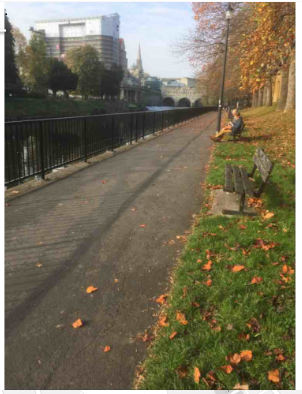Scrollen Sie nach unten, um den Beitrag auf Deutsch zu lesen /// Scroll down for reading the post in German
More than half of the world’s population lives in cities, and the trend is upwards.
With a growing urban population and denser cities, the number of people being negatively affected by noise is constantly increasing. Every year noise from road traffic affects over 125 million people only in Europe, causing physical and mental health issues, impairing our social well-being and raising questions regarding social and environmental justice.
Although being the second most common environmental stressor, noise pollution has been often neglected. To tackle this challenge, the Environmental Noise Directive was introduced in 2002 in order to establish a common approach to avoid, prevent, and reduce noise pollution among the Member States (END 49/2002).
From quantitative to qualitative approaches
Quantitative approaches, based on acoustical measurements, noise maps and noise action plans, are usually applied to address and reduce noise pollution. However noise is not only objectively quantifiable but it is also perceived subjectively, calling for integrating qualitative approaches with the quantitative ones.
The soundscape approach places people at the core of processes for the protection and improvement of the sonic environments. In doing so, the soundscape approach aims at protecting and enhancing our physical and mental health as well as our social well-being.
The soundscape approach acknowledges the meaning that sounds play in our everyday lives, therefore highlighting the positive effects that a good sonic environment has on our life.
Sound and the Healthy City – Call for papers!
Although a growing number of studies concentrate on the positive effects that a good sonic environment has on our life – e.g. focusing on issues like quietness, tranquility etc. – studies focusing on the negative effects of noise are still outnumbered.
The special issue “Sound and the Healthy City” of the Cities and Health Journal aims to help fill this gap of knowledge, “by calling for original contributions that address the topic of city sounds and health from either or both the anti-noise and soundscape perspectives”.
Contributions might revolve around, but are not limited to themes as public and public/private spaces and the built environment; new forms of mobility; new technology; urban commons, innovative policies, and form of governance; placemaking and inclusion; and ecology.
More information on the call and the kind of contributions that can be submitted can be found here.
With this issue, we hope to raise your interest on the topic of Sound and the Healthy City and we look forward to getting your contributions to the special issue!
Ps. The deadline for submission to this special issue is 25 September 2018!
Quiet regards from Berlin!
The Hush City Mobile Lab Team
Everyday Quiet Area of the week

14 N Parade, Bath BA2, UK. This everyday quiet area is rated as relaxing and it is no. 444 of the Hush City Map
Mehr als die Hälfte der Weltbevölkerung lebt in Städten, Tendenz steigend.
Mit der wachsenden Stadtbevölkerung und dichter werdenden Städten, nimmt die Zahl der von Lärm betroffenen Menschen stetig zu. Lärm durch Straßenverkehr betrifft allein in Europa über 125 Millionen Menschen jährlich und verursacht physische und psychische Gesundheitsprobleme, beeinträchtigt unser soziales Wohlbefinden und wirft Fragen der sozialen und Umweltgerechtigkeit auf.
Obwohl sie die zweithäufigste Umweltbelastung ist, wurde Lärmbelästigung vernachlässigt. Um dieser Herausforderung zu begegnen, wurde 2002 die Richtlinie über Umgebungslärm eingeführt, um einen gemeinsamen Ansatz zur Vermeidung, Vorbeugung und Verringerung der Lärmbelästigung in den Mitgliedstaaten zu etablieren (END 49/2002).
Von quantitativen zu qualitativen Ansätzen
Quantitative Ansätze, die auf akustischen Messungen, Lärmkarten und Aktionsplänen basieren, werden normalerweise genutzt, um mit Lärmbelastung umzugehen und diese zu reduzieren. Lärm ist jedoch nicht nur objektiv quantifizierbar, sondern wird subjektiv wahrgenommen und erfordert es, qualitative Ansätze in quantitative Ansätze zu integrieren.
Der Soundscape-Ansatz stellt den Menschen in den Mittelpunkt des Prozesses für den Schutz und die Verbesserung der Klangumgebungen. Damit zielt der Soundscape-Ansatz darauf ab, unsere physische und psychische Gesundheit sowie unser soziales Wohlbefinden zu schützen und zu verbessern. Der Soundscape-Ansatz erkennt die Bedeutung an, die Geräusche in unserem alltäglichen Leben spielen und hebt dafür die positiven Auswirkungen, die eine gute Klangumgebung auf unser Leben hat, hervor.
Geräusche und die gesunde Stadt – Call for papers!
Obwohl sich immer mehr Studien auf die positiven Auswirkungen, die eine gute Klangumgebung auf unser Leben hat, konzentrieren – indem sie sich mit Themen wie z.B. Ruhe, Stille usw. befassen – sind Studien, die sich auf die negativen Auswirkungen von Lärm konzentrieren nach wie vor in der Überzahl.
Die Sonderausgabe “Sound and the Healthy City” des Cities and Health Magazins zielt darauf ab, diese Wissenslücke zu füllen, indem sie zu originellen Beiträgen aufruft, die sich dem Thema Stadtgeräusche und Gesundheit, entweder aus der Anti-Lärm oder der Soundscape Perspektive, oder aus einer Kombination aus beiden widmen.
Die Beiträge können sich auf Themen wie öffentliche und öffentlich/privaten Räume und die bauliche Umwelt; Neue Formen der Mobilität; Neue Technologien; Städtische Gemeingüter, innovative Politiken und Formen der Governance; Placemaking und Inklusion sowie Ökologie beziehen.
Mehr Informationen zu dem Call und der Art der Beiträge, die eingereicht werden können, finden Sie hier.
Mit dieser Ausgabe hoffen wir, dass wir Ihr Interesse an dem Thema Geräusche und die gesunde Stadt wecken können und wir freuen uns darauf, Ihre Beiträge zu der Sonderausgabe zu erhalten!
P.S. Einsendeschluss für Beiträge zu dieser Sonderausgabe ist der 25. September 2018!
Ruhige Grüße aus Berlin!
The Hush City Mobile Lab Team